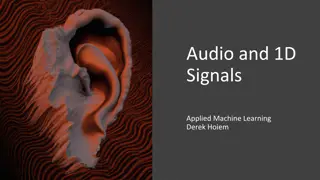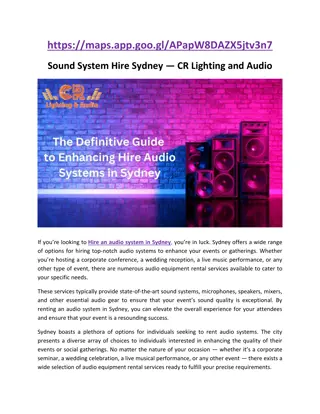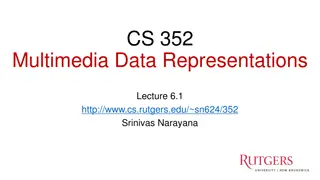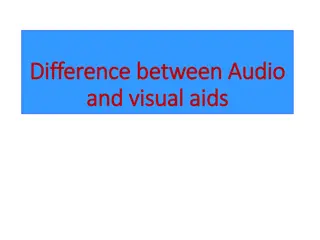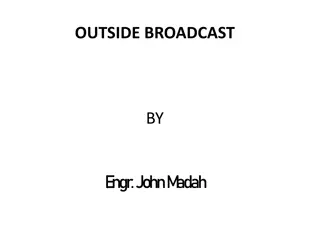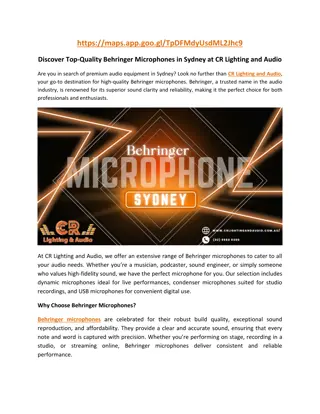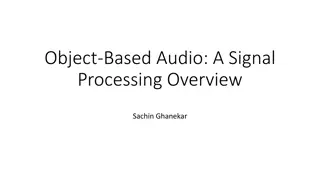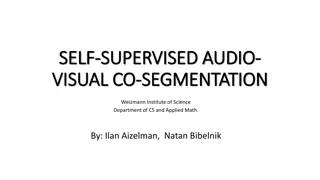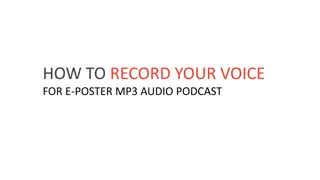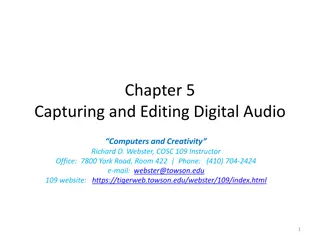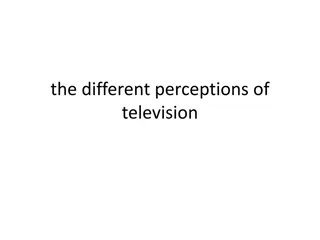Understanding Audio Basics in Television Operations
Until recently, television focused more on video than audio. However, with advancements like stereo and surround sound, audience expectations have risen. This article delves into the fundamental characteristics of sound – loudness and frequency – and explores the various decibel levels in different environments. Additionally, it explains the two different uses of the term decibel (dB) in measuring sound pressure and electrical power in audio production. Understand the dB scale and its significance in capturing sound levels accurately.
Download Presentation

Please find below an Image/Link to download the presentation.
The content on the website is provided AS IS for your information and personal use only. It may not be sold, licensed, or shared on other websites without obtaining consent from the author. Download presentation by click this link. If you encounter any issues during the download, it is possible that the publisher has removed the file from their server.
E N D
Presentation Transcript
THE FUNDAMENTAL OF AUDIO & OPERATION (TV AUDIO) Engr. Ezekiel UnekwuOjo Thomas Television Sound: The Basics Until rather recently in television far more attention was paid to video than to audio. "Good sound" was when you could make out what was being said; "bad sound" was when you couldn't. This has changed. With the advent of stereo, 5.1 surround-sound, and home theaters, etc, audiences have much higher expectations. Before we can discuss some of the basic audio production concepts, sound, itself, must be understood. Sound has two basic characteristics that must be controlled: loudness and frequency.
LOUDNESS Although sound loudness is commonly measured in decibels (dBs), that term actually refers to two different things. First is dBSPL (for sound pressure loudness), which is a measure of acoustic power. These are sounds we can directly hear with our ears. These decibels go to and beyond 135, which is considered the threshold of pain and, by the way, the point at which permanent ear damage can occur. If your ears "ring" after being around a loud sound, this should be a warning sign that you have crossed the threshold of potential hearing damage. (The damage, which is irreversible, often goes unnoticed, which probably explains why the average 50-year-old in some countries has better hearing than many young people in the U.S.) Musicians who must be around high-level sound use musician's plugs -- special earplugs that attenuate sound level without distorting the frequency range.
Various sound pressure decibel levels (dB in SPLs) Jet Aircraft Taking Off 140-150 Rock Concert / Gunshots 135-140 Jackhammer at 15 meters / Subway 85-90 Average City Street / Restaurant 70- 75 Quiet Conversation / Phone Dial Tone 60-80 Office Environment 45 Whisper at 3 meters (10 feet) 30 "Silent" TV Studio 20
WHAT IS THE SECOND USE OF THE TERM dB? The second use of the term decibel, dBm (for the milliwatt reference level) is a unit of electrical power. In audio production we are primarily interested in dBm, which represents levels of electrical power going through various pieces of audio equipment. Two types of VU (Volume Unit) meters for measuring the loudness of sound are in wide use: the digital type and the analog type.
THE PERCENTAGE/dB SCALE The 0 to 100 scale on the left side of this illustration indicates modulation percentage (percentage of a maximum signal), and the scale on the right is in dB's. Contrary to what logic might dictate, 0dBm (generally just designated 0dB on a VU meter) is not "zero sound" but, in a sense, the opposite, the maximum desirable sound level. (that's a bit confusing, but then, again, we didn't make up this system!)
THE ZERO POINT SO, WHAT IS THE ZERO POINT ON THE METER ALL ABOUT?
THE ZERO POINT The 0dB point on the meter is just a reference point. Therefore, it's possible to have a sound level on the meter that registers in negative dBs, just as it's possible to have a temperature of -10 degrees Centigrade or Fahrenheit. 10-7
HAVE YOU SEEN ANY OF THESE BEFORE? Digital meters
The animated versions above illustrate how digital meters respond to sounds.
THE VU METER The VU meter on the down right corner is the traditional analog meter that has been around in one form or another since the dawn of radio. Although easy to read, most versions do not accurately respond to short bursts of loud sound.
NOTE The dB level going through audio equipment must be carefully controlled. If the signal is allowed to pass through equipment at too low a level, noise can be introduced when the level is later increased to a normal amplitude (audio level).
EFFECT OF HIGH LEVEL AUDIO If the level is too high (significantly above 0 dB or into the red areas on the VU meter), distortion will result -- especially with digital audio. To ensure audio quality, you must pay constant attention to maintaining proper audio levels.
An over exposed Audio You probably know what an over exposed photos looks like, but what does overexposed Audio sound like? And are there other digital comparison we can make to help us understand the physics of the situation?
Clipping analogy Digital camera sensors consist of photon gathering wells. Varying the exposure by changing the apertures or shutter speed affects the number of photons that hit the sensor. If the amount of light exceed the well`s capacity or digitization range, then the sensor can`t record differences in light beyond that threshold. The well is like a bucket that has overflow with water. The sensor can`t determine if it overflowed by a drop or a gallon. Post processing can`t save overexposed photo (i.e. clipped) because clipping remain even when the gain is reduced.
Clipping analogy cont. Digital recorders capture an audio signal through a microphone or a direct input from an instrument like a synthesizer. Dedicated audio recorders typically have a gain control, which is like ISO knob on your camera. The gain amplifies the outgoing audio signal, before its increased even more by pre- amplifiers that feed into a recorder. A recording engineer uses audio meters to keep the signal under the clipping point. The final audio master is often raised to right below the clipping point.
IN SUMMARY Like an overexposed photo, listening to clipped audio isn`t pleasant. Clipped audio sound scratchy, tinny and lacks nuance and expression.
FREQUENCY Frequency Frequency relates to the basic pitch of a sound -- how high or low it is. A frequency of 20 Hz would sound like an extremely low-pitched note on a pipe organ -- almost a rumble. At the other end of the scale, 20,000 Hz would be the highest pitched sound that most people can hear, even higher than the highest note on a violin or piccolo. Frequency is measured in Hertz (Hz) or cycles per second (CPS). A person with exceptionally good hearing will be able to hear sounds from 20-20,000 Hz.
FREQ. CONT. Since both ends of the 20-20,000Hz range represent rather extreme limits, the more common range used for television production is from 50 to 15,000 Hz. Although it doesn't quite cover the full range that can be heard by people with good hearing, this range does cover almost all naturally occurring sounds.
The Frequency-Loudness Relationship Even though sounds of different frequencies may technically be equal in loudness (register the same on a VU meter), human hearing does not perceive them as being of equal strength.
CONSIDER THIS. The red line on the graph (roughly) shows the frequency response of the human ear to different frequencies. Because of the reduced sensitivity of the ear to both high and low frequencies, these sounds must be louder to be perceived as being equal to other frequencies.
NOTE: You'll note that a good-quality microphone (the green line) is relatively "flat" in the all-important 50-15,000 Hz. range.
LISTENING CONDITIONS Equipment and listening conditions also greatly affect how different frequencies will be perceived. To compensate for some of these problems, we can adjust bass and treble controls of playback equipment.
THE EQ. More sophisticated equipment will include a graphic equalizer, which goes a step further and allows specific bands of frequencies to be individually adjusted for loudness. A graphic equalizer may be necessary to help match audio segments recorded under different conditions, or simply to customize audio playback to the acoustics of a specific listening area.
Any piece of audio equipment -- microphone, amplifier, recorder, or audio speaker -- can adversely affect the fidelity of sound. However, it's the microphone (the initial device that transduces sound waves into electrical energy) and the audio speaker (the device that changes electrical energy back into sound waves) that represent the weakest links in audio quality.
THINK ABOUT THIS. To some degree it's possible to use graphic equalizers and similar audio equipment to "clean up" the frequency response of a poor microphone. However, even the most sophisticated audio techniques can't work miracles. Thus, the better the original audio signal, the better the final product will be.
Room Acoustics Sound, both as it's recorded and played back, is more affected by the acoustics of a room or studio than most people realize. In an effort to create totally soundproof studios, early radio stations used to use thick carpets on the floors and heavy soundproofing on the walls. Although possibly successful as soundproofing, the result was a lifeless and dead effect that we're not used to hearing in a normal listening situation, such as our living room.
Sound proofing Therefore, a slight bit of reverberation is both desirable and realistic. Two types of soundproofing material are shown on the down left corner bellow:-
Effect of the Room. A room with a tile floor and hard, parallel walls will reflect sound so much that it interferes with the intelligibility of speech. Sometimes it's desirable in these situations to place freestanding sound absorbing items in the room -- things like sofas and rugs -- to break up sound reflections and reduce reverberation. The ideal room for recording or listening to sound has just enough reverberation to sound realistic, possibly similar to your living room, but not enough to reduce the intelligibility of speech.
THE END THANK YOU FOR YOUR ATTENTION.
A presentation by ENGR. EZEKIEL UNEKWUOJO THOMAS


